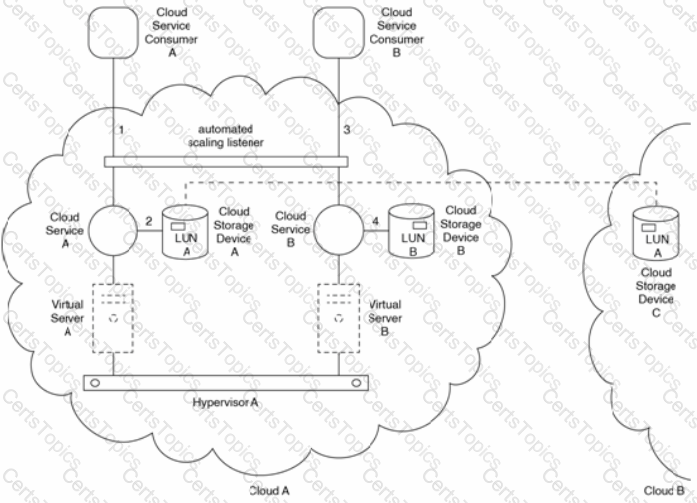Cloud Service A is hosted by Virtual Server A. Cloud Storage Device A contains LUN A. Cloud Storage Device A is a multi-tiered cloud storage device with different types of disk groups that perform at different levels. LUN A is located in the disk group with the highest performance level. Cloud Service B is hosted by Virtual Server B. Virtual Servers A and B are hosted by HypervisorA, which is installed on a physical server (not shown) that resides in Cloud A. A redundant implementation of LUN A is replicated synchronously to Cloud Storage Device C. Cloud Storage Device C does not support multiple types of disk groups and resides in Cloud B, which is located in a different geographic region than Cloud A. Requests that cloud service consumers send to Cloud Services A and B are intercepted by an automated scaling listener responsible for initiating scaling activities.

Cloud Service Consumer A issues a request to Cloud Service A (1). To process the request, Cloud Service A accesses LUN Aon Cloud Storage Device A (2). Cloud Service Consumer B issues a request to Cloud Service B (3). To process the request, Cloud Service B accesses LUN B on Cloud Storage Device B (4).
When Cloud Service Consumer A accesses Cloud Service A, there is usually no noticeable performance fluctuation, even during peak usage periods. However, recently, Cloud Storage Device A became unexpectedly unavailable, requiring that Cloud Service A access LUN A on Cloud Storage Device C instead. During the following outage period for Cloud Storage Device A, Cloud Service Consumer A encounters inconsistent performance from Cloud Service A, including unusual delays that occur whenever the data requested by Cloud Consumer A isn't cached and Cloud Service A is required to retrieve the data from LUN A.
Which of the following statements describes a solution that can address this problem?